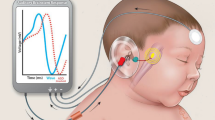Abstract
Brainstem auditory evoked potentials were compared in 109 children with infantile autism, 38 with autistic condition, 19 with mental retardation, and 20 normal children. Children with infantile autism or autistic condition had significantly longer brainstem transmission time than normal (p<.001). Autistic features, rather than age, sex, or lower mentality, correlated with brainstem transmission time (p<.0001). The autistic characteristics may be related to dysfunction of the brainstem which affects the processing of the sensory input through the auditory pathway. The brainstem lesion may be part of a generalized process of neurological damage that accounts for the deviant language, cognitive, and social development in the spectrum of autistic disorder.
Similar content being viewed by others
References
American Psychiatric Association. (1987). Diagnostic and statistical manual of mental disorders (3rd ed., rev., pp. 33–39). Washington, DC: Author.
Courchesne, E., Kilman, B. A., Galambos, R., & Lincoln, A. J. (1984). Autism: Processing of novel auditory information assessed by event related brain potentials.Electroencephalography and Clinical Neurology, 59, 238–248.
Courchesne, E., Courchesne, R. Y., Hicks, G., & Lincoln, A. J. (1985). Functioning of the brainstem auditory pathway in non-retarded autistic individuals.Electroencephalography and Clinical Neurophysiology, 61, 491–501.
Courchesne, E., Hesselink, J. R., Jernigan, T. L., & Yeung-Courchesne, R. (1987). Abnormal neuroanatomy in a nonretarded person with autism. Unusual findings in magnetic resonance imaging.Archives of Neurology, 44, 335–340.
Courchesne, E., Lincoln, A. J., Kilman, B. A., & Galambos, R. (1985). Event-related brain potential correlates of the processing of novel visual and auditory information in autism.Journal of Autism and Developmental Disorders, 15, 55–76.
Courchesne, E., Yeung-Courchesne, R., Press, G. A., Hesselink, J. R., & Jernigan, T. L. (1988). Hypoplasia of cerebellar vermal lobules VI and VII in autism.New England Journal of Medicine, 318, 1349–1354.
Doll, E. A. (1965).Vineland Social Maturity Scale Manual (3rd Ed.). American Guidance Service.
Ferri, R., Bergonzi, P., Colognola, R. M., Musumeci, S. A., Sanfilippo, S., Tomassetti, P., Viglianesi, A., & Gigli, G. L. (1986). Brainstem auditory evoked potentials in subjects with mental retardation and different karyotypes. In V. Gallai (Ed.),Maturation of the CNS and evoked potentials (369–374). Amsterdam, The Netherlands: Elsevier.
Gillberg, C., Rosenthal, U., & Johansson, E. (1983). Auditory brainstem responses in childhood psychosis.Journal of Autism and Developmental Disorders, 13, 181–195.
Griffiths, R. (1970).The abilities of young children. London: Children Research Centre.
Hecox, K. (1982). Pediatric applications of the brainstem auditory evoked response. In G. A. Chiarenza & D. Papakostopoulos (Eds.),Proceedings of the International Conference on Clinical Application of Cerebral Evoked Potentials in Pediatric Neurology (pp. 397–414). Amsterdam, The Netherlands: Excerpta Medica.
Hecox, K., & Galambos, R. (1974). Brainstem auditory evoked responses in human infants and adults.Archives of Otolaryngology, 99, 30–33.
Martineau, J., Garreau, B., & Lelord, G. (1987). Auditory evoked responses and their modifications during conditioning paradigm in autistic children.Journal of Autism and Developmental Disorders, 17, 525–539.
Moller, R., & Jannetta, P. J. (1985). Neural generators of the auditory brainstem response. In J. T. Jacobson (Ed.),The auditory brainstem response (Chap. 2, pp. 13–32). London: Taylor & Francis.
Novick, B., Kurtzberg, A., & Vaughan, H. G., Jr. (1979). An electrophysiologic indication of defective information storage in childhood autism.Psychiatry Research, 3, 107–114.
O'Donoran, C. A., Beagley, H. A., & Shaw, H. (1980). Latency of brainstem responses in children.British Journal of Audiology, 14, 23–29.
Ornitz, E. M., & Walter, D. O. (1975). The effect of sound pressure waveform on human brainstem auditory evoked responses.Brain Research, 92, 490–498.
Ornitz, E. M., Mo, A., & Olson, S. T. (1980). Influence of click sound pressure direction on brainstem responses in children.Audiology, 19, 245–254.
Ritvo, E. R., Creel, D., Realmuto, G., Crandall, A. S., Freeman, B. J., Bateman, J. B., Barr, R., Pingree, C., Coleman, M., & Purple, R. (1988). Electroretinograms in autism: a pilot study of b-wave amplitudes.American Journal of Psychiatry, 145, 229–232.
Ritvo, E. R., Freeman, B. J., Scheilbel, A. B., Duong, T., Robinson, H., Guthrie, D., & Ritvo, A. (1986). Lower purkinje cell counts in the cerebella of four autistic subjects: initial findings of the UCLA-NSAC autopsy research report.American Journal of Psychiatry, 143, 862–866.
Rosenblum, S. M., Arick, J. R., Krug, D. A., Stubbs, E. G., Young, N. B., & Pelson, R. O. (1980). Auditory brainstem evoked responses in autistic children.Journal of Autism and Developmental Disorders, 10, 215–225.
Rutter, M. (1978). Diagnosis and definition. In M. Rutter & E. Schopler (Eds.),Autism: A reappraisal of concepts and treatments. New York: Plenum Press.
Rutter, M. (1985). Infantile autism and other pervasive developmental disorders. In M. Rutter & L. Hersov (Eds.),Child and adolescent psychiatry (2nd ed., pp. 545–566). London: Blackwell.
Skoff, B. F., Mirsky, A. F., & Turner, D. (1980). Prolonged brainstem transmission time in autism.Psychiatric Research, 2, 157–166.
Sohmer, H., & Student, M. (1978). Auditory nerve and brainstem evoked response in normal, autistic, minimal brain dysfunction and psychomotor retarded children.Electroencephalography and Clinical Neurophysiology, 44, 380–388.
Stockard, J. J., Stockard, J. E., & Sharbrough, F. W. (1978). Non-pathologic factors influencing brainstem auditory evoked potentials.American Journal of EEG Technology, 18, 117–209.
Stockard, J. J., Stockard, J. E., & Sharbrough, F. W. (1980). Brainstem auditory evoked potentials in neurology: Methodology, interpretation, clinical application. In M. J. Aminoff (Ed.),Electrodiagnosis in clinical neurology (pp. 383–384). London: Churchill Livingstone.
Student, M., & Sohmer, H. (1978). Evidence from auditory nerve and brainstem evoked responses for an organic brain lesion in children with autistic traits.Journal of Autism and Childhood Schizophrenia, 8, 13–20.
Tanguay, P. E., & Edwards, R. (1982). Electrophysiological studies of autism: The whisper of the bang.Journal of Autism and Developmental Disorders, 12, 177–184.
Tanguay, P. E., Edwards, R. M., Buchwald, J., Schwafel, J., & Allen, V. (1982). Auditory brainstem responses in autistic children.Archives of General Psychiatry, 39, 174–180.
Author information
Authors and Affiliations
Additional information
We thank R. Ko and F. Pun for their scretarial assistance.
Rights and permissions
About this article
Cite this article
Wong, V., Wong, S.N. Brainstem auditory evoked potential study in children with autistic disorder. J Autism Dev Disord 21, 329–340 (1991). https://doi.org/10.1007/BF02207329
Issue Date:
DOI: https://doi.org/10.1007/BF02207329




